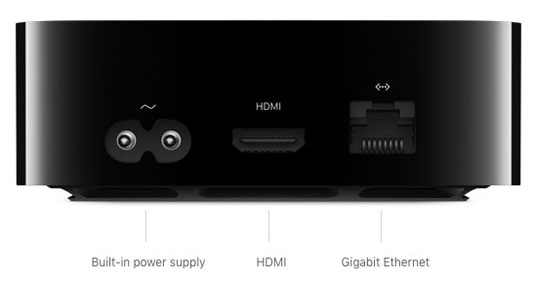Hosted by site sponsor WebMate.
Apple TV Q&A
Update Published May 25, 2021
Also see: All Apple Q&As >> Apple TV Q&A (Home)
To be notified of new Q&As, sign up for EveryMac.com's bimonthly email list.
How do you connect the black Apple TV models to a television?
Before attempting to connect a black Apple TV 2nd Gen, Apple TV 3rd Gen, Apple TV 4th Gen, Apple TV 4K or Apple TV 4K (2nd Gen), to a television, note that these devices only are compatible with an HDTV with HDMI support. None support component video or audio.

Photo Credit: Apple, Inc. (Apple TV 4K Ports)
At the time of its introduction, Apple formally states that the black Apple TV 2nd Gen models are compatible with:
High-definition TVs with HDMI and capable of 720p 60/50 Hz including popular models from these manufacturers: Hitachi, JVC, LG, Mitsubishi, NEC, Panasonic, Philips, Pioneer, Samsung, Sony, Sharp, Toshiba, Vizio, and Westinghouse.
For the Apple TV 3rd Gen and Apple TV 4th Gen, Apple simply states that the devices are compatible with "high-definition TVs with HDMI." It also is worth noting that some have reported video distortion on older HDTVs when attempting to use theses Apple TV models, so it would be wise to confirm that your particular television is fully compatible prior to purchasing the device.
For the Apple TV 4K and Apple TV 4K (2nd Gen), Apple notes that the device is compatible with "HD and UHD TVs with HDMI" support.
Apple explains how to connect the black Apple TV models to a television in the applicable User's Guide, specifically from pages 10-13. In addition to a compatible HDTV, you will need an HDMI cable. You also will need to have an 802.11b or faster wireless network for use via wi-fi, a broadband Internet connection, and any needed usernames and passwords.
For the benefit of those who have asked, Apple's official instructions additionally are provided below:
Step 1: Connecting the cables
- Connect one end of an HDMI cable to the back of your TV.
- Connect the other end of the cable to the HDMI port on the back of Apple TV.
- If you're using an optical digital audio cable for audio, connect one end of the cable to the audio input port on your receiver or TV, and the other end to the optical digital audio port on the back of Apple TV. This only applies to the Apple TV 2nd Gen and Apple TV 3rd Gen models as the Apple TV 4th Gen and Apple TV 4K do not have an optical audio port at all.
Note: The built-in Wi-Fi connects Apple TV to your wireless network. If your network is Ethernet-based, connect Apple TV to your network using an Ethernet cable.
Step 2: Connect the power cord
Connect one end of the power cord to the power port on the back of Apple TV and the other end to a power outlet.
Important: Don't place anything on top of Apple TV. Objects placed on top may interfere with the wireless signal. Don’t place Apple TV on other electronic equipment in a media cabinet.
Step 3: Turn on your TV and select the input
If you see just a black screen the first time you use Apple TV, make sure the input setting you've selected on your TV matches the input you connected the cables to on your TV or home theater receiver.
Also see: How do you connect the original Apple TV to a television? How do you connect the original Apple TV to a Mac or PC?
Permalink | Report an Error/Typo | Sign Up for Site Update Notices
Established in 1996, EveryMac.com has been created by experts with decades of experience with Apple hardware. EveryMac.com includes, and always has included, original research incorporating detailed, hands-on inspection of packaging, computers, and devices as well as extensive real-world use. All information is provided in good faith, but no website or person is perfect. Accordingly, EveryMac.com is provided "as is" without warranty of any kind whatsoever. EveryMac.com, and the authors thereof, shall not be held responsible or liable, under any circumstances, for any damages resulting from the use or inability to use the information within. For complete disclaimer and copyright information please read and understand the Terms of Use and the Privacy Policy before using EveryMac.com. Copying, scraping, or use of any content without expressed permission is not allowed, although links to any page are welcomed and appreciated.
